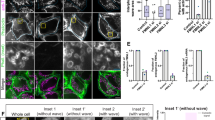Abstract
Apaf-1-interacting protein (APIP) was previously isolated as an inhibitor of mitochondrial cell death interacting with Apaf-1. Here, we report a hypoxia-selective antiapoptotic activity of APIP that induces the activation of AKT and extracellular signal-regulated kinase (ERK)1/2. Stable expression of APIP in C2C12 (C2C12/APIP) cells suppressed cell death induced by hypoxia and etoposide. Unlike etoposide, however, APIP induces the sustained activation of AKT and ERK1/2 and the phosphorylation of caspase-9 during hypoxia. Inhibition of AKT and ERK1/2 activation by the treatments with phosphatidylinositol 3′-kinase and mitogen-activated protein kinase kinase (MEK)1/2 inhibitors sensitized C2C12/APIP cells to hypoxic cell death and abolished the hypoxia-induced phosphorylation of caspase-9. Further, overexpression of phosphorylation-mimic caspase-9 mutants (caspase-9-T125E and caspase-9-S196D), but not phosphorylation-defective caspase-9 mutants (caspase-9-T125A and caspase-9-S196A), effectively suppressed hypoxia-induced death of C2C12 cells. These results elucidate a novel Apaf-1-independent antiapoptotic activity of APIP during hypoxic cell death, inducing the sustained activation of AKT and ERK1/2 and leading to caspase-9 phosphorylation.
This is a preview of subscription content, access via your institution
Access options
Subscribe to this journal
Receive 50 print issues and online access
$259.00 per year
only $5.18 per issue
Buy this article
- Purchase on Springer Link
- Instant access to full article PDF
Prices may be subject to local taxes which are calculated during checkout




Similar content being viewed by others
References
Allan LA, Morrice N, Brady S, Magee G, Pathak S, Clarke PR et al. (2003). Inhibition of caspase-9 through phosphorylation at Thr 125 by ERK MAPK. Nat Cell Biol 5: 647–654.
Cardone MH, Roy N, Stennicke HR, Salvesen GS, Franke TF, Stanbridge E et al. (1998). Regulation of cell death protease caspase-9 by phosphorylation. Science 282: 1318–1321.
Chen EY, Mazure NM, Cooper JA, Giaccia AJ . (2001). Hypoxia activates a platelet-derived growth factor receptor/phosphatidylinositol 3-kinase/Akt pathway that results in glycogen synthase kinase-3 inactivation. Cancer Res 61: 2429–2433.
Chen J, Zhao S, Nakada K, Kuge Y, Tamaki N, Okada F et al. (2003). Dominant-negative hypoxia-inducible factor-1 alpha reduces tumorigenicity of pancreatic cancer cells through the suppression of glucose metabolism. Am J Pathol 162: 1283–1291.
Cho DH, Hong YM, Lee HJ, Woo HN, Pyo JO, Mak TW et al. (2004). Induced inhibition of ischemic/hypoxic injury by APIP, a novel Apaf-1-interacting protein. J Biol Chem 279: 39942–39950.
Dang CV, Semenza GL . (1999). Oncogenic alterations of metabolism. Trends Biochem Sci 24: 68–72.
Datta SR, Dudek H, Tao X, Masters S, Fu H, Gotoh Y et al. (1997). Akt phosphorylation of BAD couples survival signals to the cell-intrinsic death machinery. Cell 91: 231–241.
Du K, Montminy M . (1998). CREB is a regulatory target for the protein kinase Akt/PKB. J Biol Chem 273: 32377–32379.
Jiang Z, Zhang Y, Chen X, Lam PY, Yang H, Xu Q et al. (2002). Activation of Erk1/2 and Akt in astrocytes under ischemia. Biochem Biophys Res Commun 294: 726–733.
Le Gall M, Chambard JC, Breittmayer JP, Grall D, Pouyssegur J, Van Obberghen-Schilling E . (2000). The p42/p44 MAP kinase pathway prevents apoptosis induced by anchorage and serum removal. Mol Biol Cell 11: 1103–1112.
Mottet D, Michel G, Renard P, Ninane N, Raes M, Michiels C . (2003). Role of ERK and calcium in the hypoxia-induced activation of HIF-1. J Cell Physiol 194: 30–44.
Romashkova JA, Makarov SS . (1999). NF-kappa B is a target of AKT in anti-apoptotic PDGF signaling. Nature 401: 86–90.
Rytomaa M, Lehmann K, Downward J . (2000). Matrix detachment induces caspase-dependent cytochrome c release from mitochondria: inhibition by PKB/Akt but not Raf signalling. Oncogene 19: 4461–4468.
Yanez AJ, Ludwig HC, Bertinat R, Spichiger C, Gatica R, Berlien G et al. (2005). Different involvement for aldolase isoenzymes in kidney glucose metabolism: aldolase B but not aldolase A colocalizes and forms a complex with FBPase. J Cell Physiol 202: 743–753.
Acknowledgements
This work was supported by the grants from Brain Research Center of 21C Frontier Research Program, Basic Research Program and Functional Cellulomics Research Center of the Korea Science and Engineering Foundation.
Author information
Authors and Affiliations
Corresponding author
Additional information
Supplementary Information accompanies the paper on the Oncogene website (http://www.nature.com/onc).
Rights and permissions
About this article
Cite this article
Cho, DH., Lee, HJ., Kim, HJ. et al. Suppression of hypoxic cell death by APIP-induced sustained activation of AKT and ERK1/2. Oncogene 26, 2809–2814 (2007). https://doi.org/10.1038/sj.onc.1210080
Received:
Revised:
Accepted:
Published:
Issue Date:
DOI: https://doi.org/10.1038/sj.onc.1210080
Keywords
This article is cited by
-
Six potential biomarkers for bladder cancer: key proteins in cell-cycle division and apoptosis pathways
Journal of the Egyptian National Cancer Institute (2022)
-
Cardioprotective role of APIP in myocardial infarction through ADORA2B
Cell Death & Disease (2019)
-
Non-viral systemic delivery of siRNA or antisense oligonucleotides targeted to Jun N-terminal kinase 1 prevents cellular hypoxic damage
Drug Delivery and Translational Research (2011)
-
Genome-wide association and linkage identify modifier loci of lung disease severity in cystic fibrosis at 11p13 and 20q13.2
Nature Genetics (2011)
-
Mechanisms of apoptosis in Crustacea: what conditions induce versus suppress cell death?
Apoptosis (2010)



